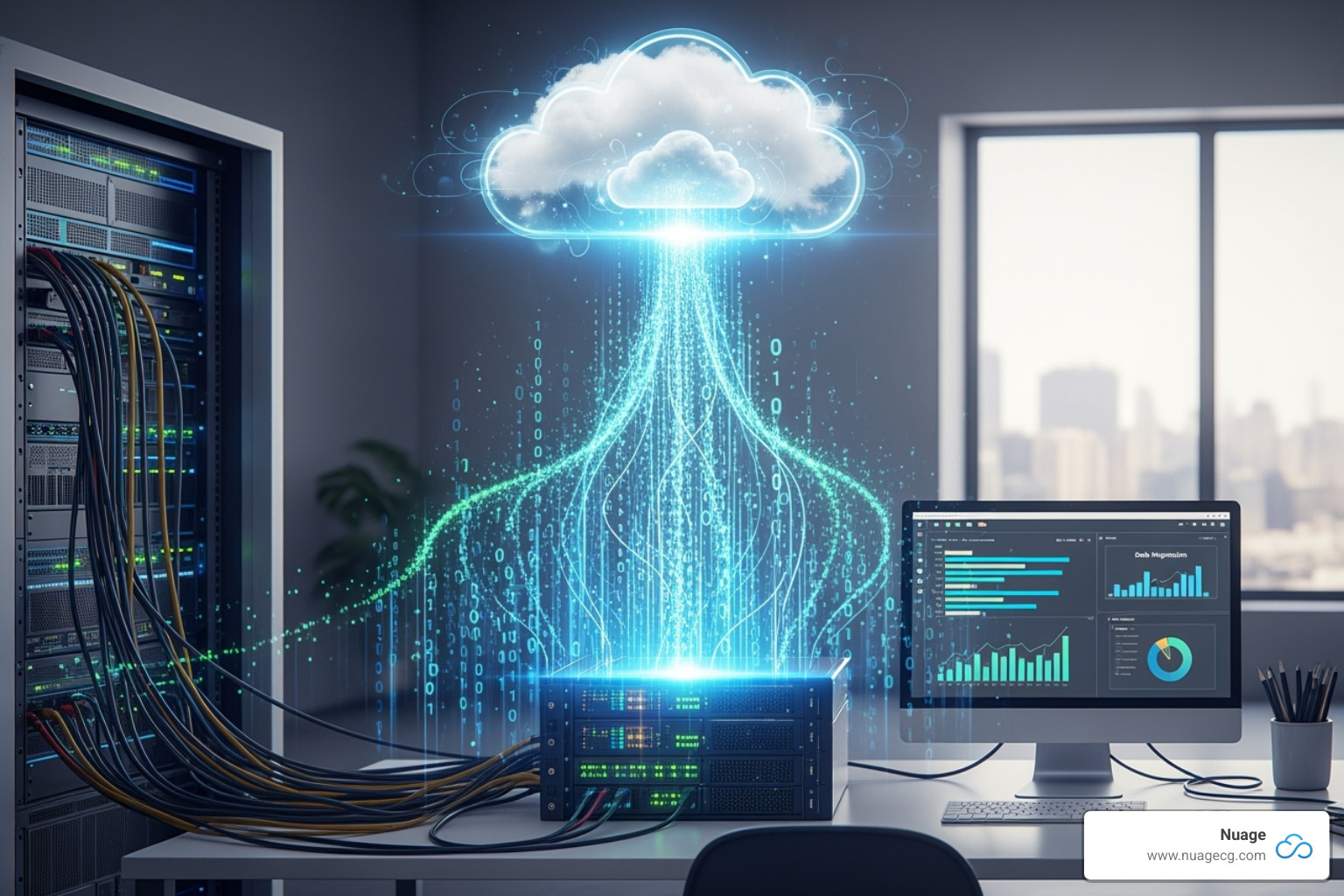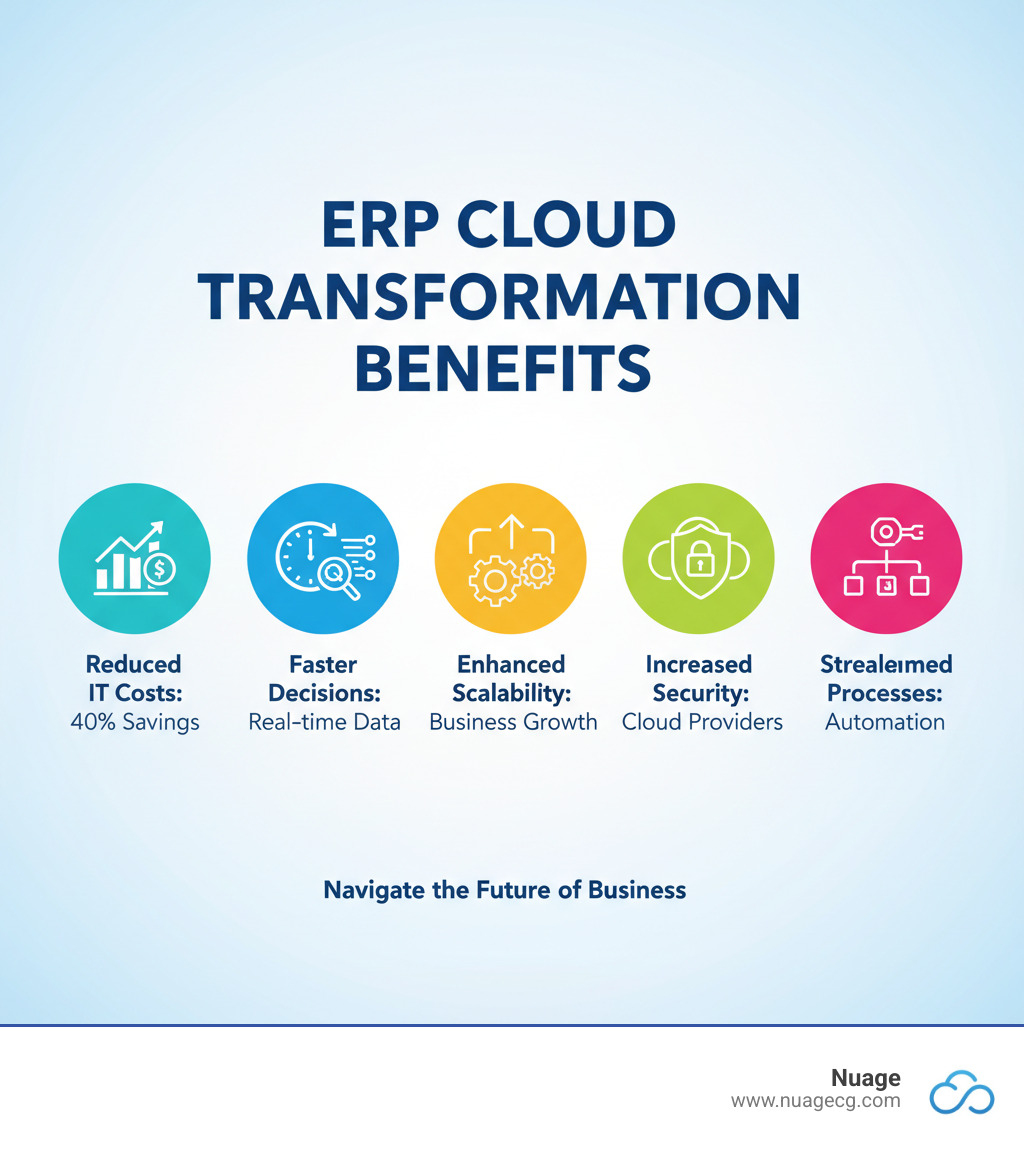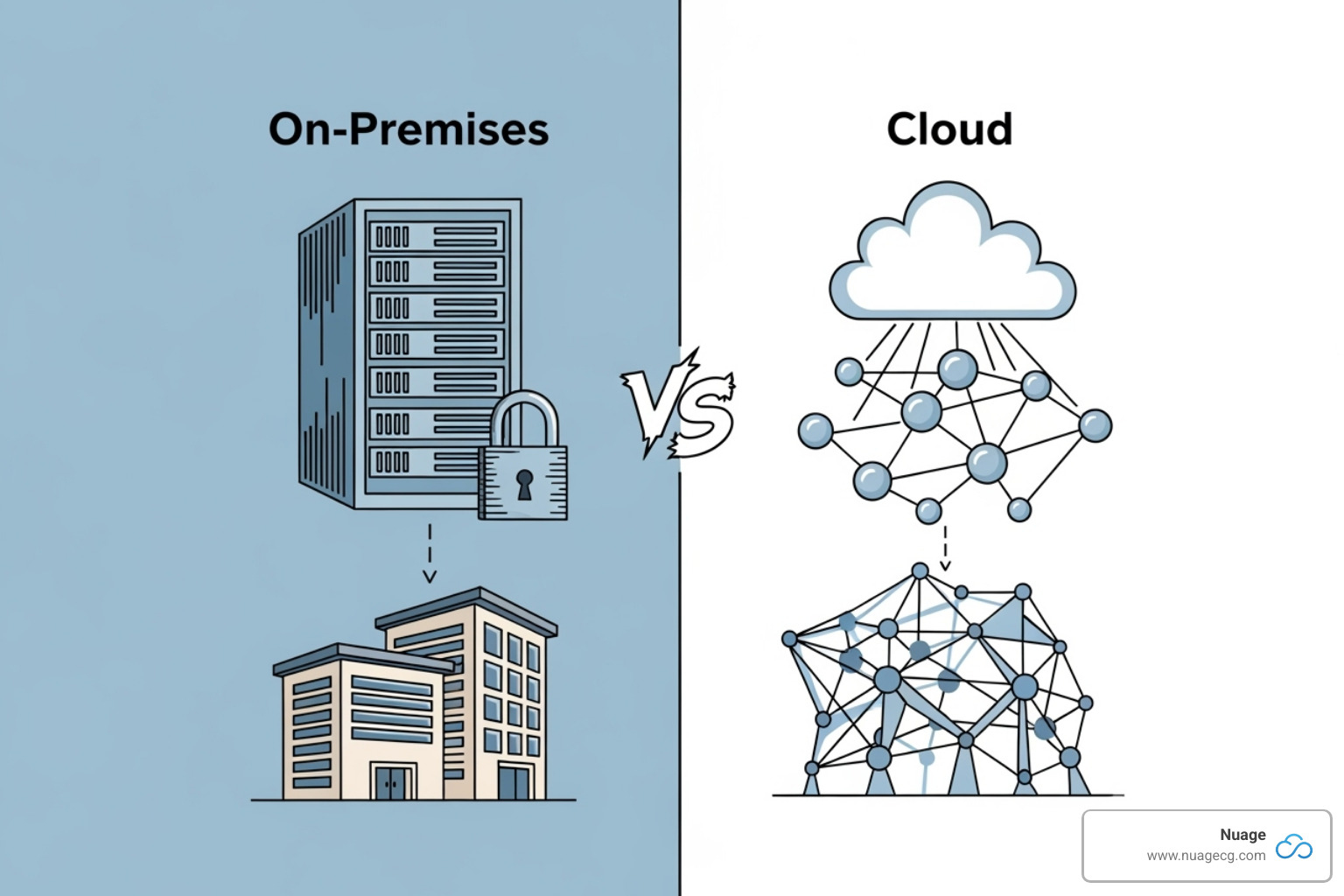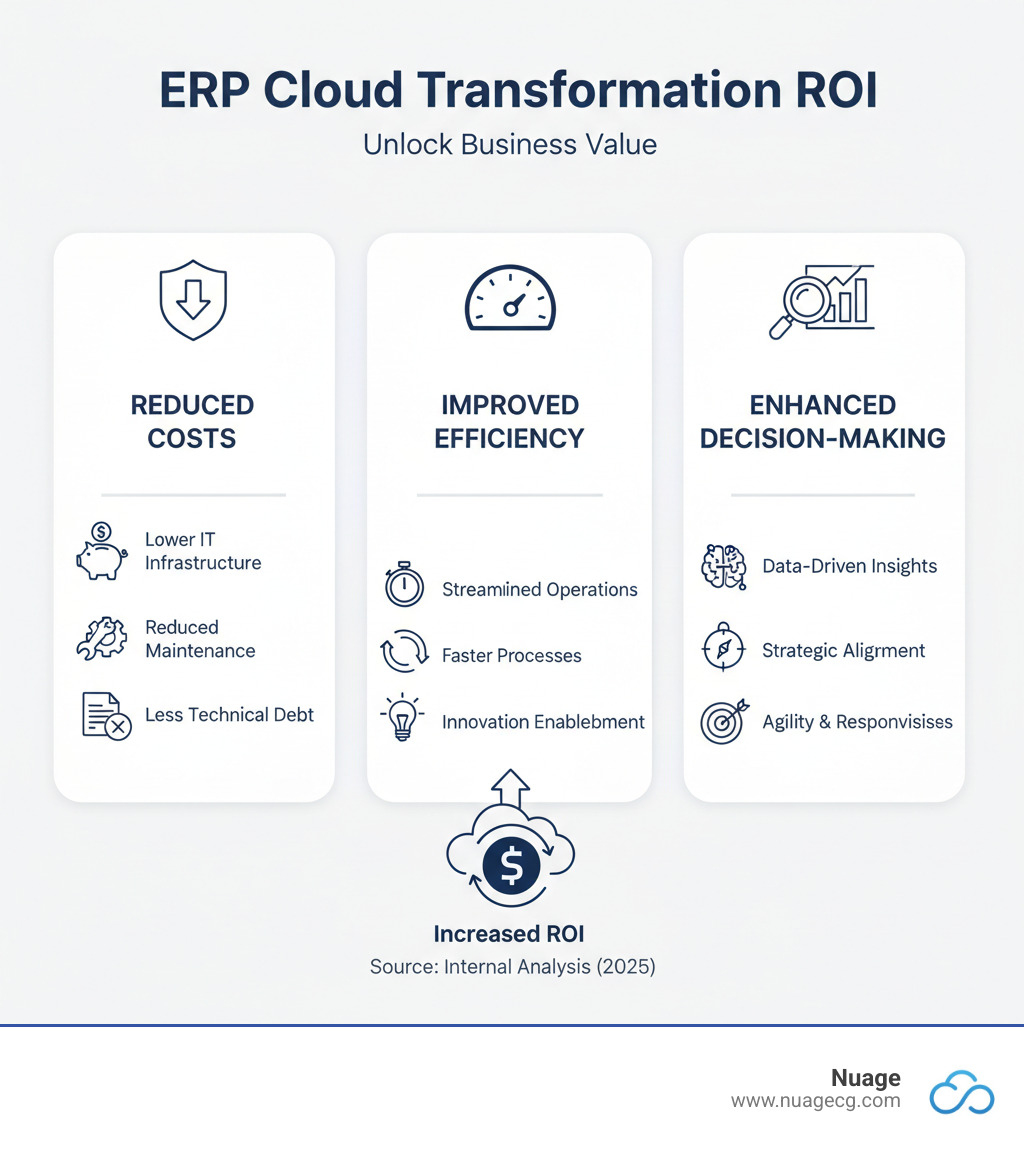Why ERP Cloud Change is Critical for Modern CIOs

ERP cloud change is the migration of enterprise resource planning systems from on-premises servers to cloud platforms, a move that fundamentally transforms core business operations.
Key ERP Cloud Change Strategies:
- Phased Migration: Gradual system migration to minimize business disruption
- Big Bang Approach: Complete system replacement in one go for faster results
- Hybrid Model: Combining cloud and on-premises systems for maximum flexibility
- Data-First Strategy: Prioritizing data cleansing and migration planning
- Change Management: Focusing on employee adoption and cultural change
The numbers tell a compelling story. 76% of businesses have already moved or are in the process of moving their on-premises ERP systems to the cloud, while 63% of companies now choose cloud ERP over traditional on-premises solutions. This shift isn’t just about technology—it’s about survival in an increasingly digital marketplace.
The CIO-CFO partnership has become more critical than ever. As one industry expert noted, “The CIO-CFO dynamic is changing. It’s a critical partnership for any ERP change journey that must balance demands for better financial reporting, business process change and cloud migration.”
Legacy on-premises ERPs are expensive, difficult to scale, and hinder innovation. In contrast, cloud ERP solutions provide the agility, scalability, and cost-effectiveness modern businesses need to compete.
For organizations already using NetSuite, the change often involves optimizing existing cloud capabilities. Many companies only use 20% of their ERP system’s potential, missing opportunities for process automation, advanced analytics, and seamless integrations.
I’m Louis Balla, and I’ve spent over 15 years guiding companies through ERP cloud change projects, helping them open up the full potential of their digital infrastructure. Through my experience at Nuage and hosting the Beyond ERP podcast, I’ve seen how the right change strategy can revolutionize business operations.

The ‘Why’: Key Drivers for Migrating to Cloud ERP
In today’s market, competitors are moving faster and adapting quicker. This is why ERP cloud change has become a necessity for businesses serious about staying competitive.
The ERP software market is expected to grow to $300 billion by 2027, with 1.4 million companies projected to spend $183 billion on ERP software in 2024. This isn’t just growth – it’s a revolution.
At Nuage, we’ve guided hundreds of companies through this change over our 20+ years in the business. Successful ERP cloud change isn’t just about moving data; it’s about reimagining how your business operates in a world that demands business agility, scalability, cost efficiency, and rock-solid security.
Traditional on-premises systems can’t keep up with modern demands for faster responses, remote work capabilities, and real-time financial visibility. Cloud ERP systems are built for this reality, enabling businesses to work seamlessly with partners while managing complex internal processes. This shift is at the heart of digital change, changing your entire approach to business operations.

Opening up Business Process Automation
Manual processes like invoice approvals, payroll calculations, and inventory counts are inefficient and error-prone. ERP cloud change is the solution, as it doesn’t just digitize these processes—it automates them. This means streamlining workflows and reducing manual errors that cost your business money and credibility.
For example, instead of manually entering invoice data, tools like the NetSuite Bill Capture module can automatically capture, route, and process payments, making the entire invoice-to-pay process hands-off. The same applies to payroll automation, which handles complex calculations and compliance, freeing your HR team to focus on supporting your people.
With 38% of companies planning to add more barcode scanners and SKUs to improve inventory accuracy, it’s clear that automation is key. When your inventory system updates in real-time, you can trust your stock numbers. This automation frees up your team for strategic activities that grow the business.
Gaining a Competitive Edge with Data
Data silos, where information is scattered across disconnected systems, kill competitive advantage. 71% of companies believe that decisions are delayed if ERP data is unavailable, and 69% report that data analysis is delayed.
Cloud ERP breaks down these barriers, providing a unified view of your entire operation where sales, inventory, financial, and customer service data are all connected.
This enables real-time analytics, allowing you to make decisions based on what’s happening now, not last month. You can instantly check product line profitability, identify at-risk customers, or see cash flow projections. Furthermore, 71% of businesses want to use ERP data for predictive analytics. Predictive analytics helps you spot trends, optimize resources, and identify new opportunities before your competitors.
Tools like SuiteAnalytics from NetSuite turn raw data into actionable intelligence, replacing gut feelings with solid, data-driven decisions that provide a real competitive edge.
Benefits for Mid-Sized Companies
ERP cloud change is ideal for mid-sized companies that have outgrown simple solutions but lack the resources for massive, traditional enterprise systems.
Traditional on-premises ERPs come with huge upfront costs for servers, licenses, and maintenance. Cloud ERP uses a predictable subscription model, converting large capital expenditures into manageable operational expenses that are easy to budget.
This model gives you access to the same powerful, enterprise-grade features that Fortune 500 companies use, including advanced reporting, sophisticated automation, and global capabilities, without the enterprise-level complexity or cost.
The agility factor is also huge. You can scale up quickly to handle new locations, seasonal staff, or acquisitions. Your ERP grows with you instead of holding you back. This improved cash flow visibility transforms decision-making, allowing you to make better, faster choices based on real-time financial data.
If you’re ready to explore how NetSuite can transform your growing business, we’d love to show you what’s possible. Learn more about NetSuite’s cloud ERP capabilities and how it can address your specific business needs.
On-Premises vs. Cloud ERP: A CIO’s Comparison
For a CIO, choosing between on-premises and cloud ERP is a pivotal decision that shapes the organization’s future. On-premises ERP means you own and manage the entire infrastructure in-house, from servers to security. Cloud ERP shifts this responsibility to a provider, with the system accessed via the internet. The vendor handles infrastructure, security, and maintenance, freeing up your internal resources.
The numbers show a clear trend: in a recent survey, 63% of businesses selected cloud ERP software over on-premises ERP. This is a fundamental shift in how organizations approach their core business systems.

The deployment model difference is just the beginning. Cloud ERP can be implemented in weeks, while on-premises systems take months of planning and installation. Your team can start realizing benefits while competitors are still waiting on hardware.
Cost structure is a major mindset shift. On-premises ERP requires massive upfront capital expenditure (CapEx). Cloud ERP converts these costs to operational expenditures (OpEx) through a predictable subscription model, which CFOs prefer for budgeting and forecasting.
Regarding maintenance and upgrades, the contrast is stark. On-premises systems require your team to manage every update, often with expensive consultants and risk. Cloud providers handle this automatically, ensuring you always have the latest features and security patches.
Scalability is where cloud ERP truly shines. Adding new users or locations is a simple request, whereas on-premises systems require purchasing and configuring new hardware, a process that can take weeks.
The security responsibility shift is significant. Instead of your team managing everything, cloud providers employ dedicated security teams and invest millions in protections and certifications that most companies cannot afford internally.
Accessibility is crucial in a remote-work world. Cloud ERP works from anywhere with an internet connection, enabling global collaboration. On-premises systems often require complex and slow VPN setups, creating bottlenecks for remote employees.
For CIOs evaluating an ERP cloud change, this comparison reveals why the move is so compelling. It’s about freeing your team to focus on strategic innovation. With a partner like Nuage and a platform like NetSuite, you get a platform that grows with your business, not just software.
Crafting Your ERP Cloud Change Strategy: Best Practices for Success
A successful ERP cloud change requires a solid roadmap from day one. Your strategy will be the deciding factor between a smooth transition and a struggle.
Your first big decision is choosing between a phased implementation and a Big Bang approach. A phased rollout is less disruptive but takes longer, while the Big Bang approach delivers faster results but with more initial upheaval. The right choice depends on your organization’s specific circumstances.
What matters most is setting clear objectives upfront. Whether you aim to cut costs, improve inventory accuracy, or speed up your financial close, these goals will guide every decision.
As industry research highlights, success goes beyond technology. It’s about reducing both technical and business process debt while aligning ERP initiatives with real business outcomes. This is where our experience helps you see the bigger picture.

The Critical Role of the CIO and CFO
After 20+ years in this business, we’ve learned that ERP cloud change is a business change enabled by technology, not just an IT project. The most successful projects share one common element: a rock-solid partnership between the CIO and CFO.
The CIO provides the technical vision, while the CFO ensures every dollar spent delivers measurable value. Together, they build compelling business cases, secure budgets, and take joint ownership of the project’s success. This collaboration is key to looking beyond ERP to achieve broader digital change.
Managing the Cultural Shift and Driving Adoption
An ERP system is only as good as its adoption rate. If your people don’t use it properly, the investment is wasted. Managing the cultural shift is often the most challenging part of the change.
People naturally resist changes to their daily routines. Effective change management starts with clear communication, explaining not just what is changing, but why it matters to them and the business. Will it make their job easier? Will it help the company grow?
Executive sponsorship is crucial. When leaders actively support the new system, it signals its importance. We also help organizations identify change agents—influential employees who can advocate for the new system and support their colleagues through the transition. Our customer stories show that companies investing in the human side of change see higher adoption and faster time to value.
Choosing the Right Implementation Partner
Choosing the right implementation partner is critical for success. Technical expertise is a baseline requirement, but it’s not enough. You need a partner who understands your industry, challenges, and growth path.
Look for a partner with a proven methodology and industry experience that matches your sector. A partner who has worked in your space will anticipate challenges and provide relevant solutions. The post-launch support model is also important. At Nuage, we pride ourselves on being a long-term partner, not just an initial implementer.
If you’re considering NetSuite, you need a certified partner with a track record of successful projects. If you require integration with other platforms like Salesforce, ensure your partner has deep expertise across your entire tech stack. The right partner doesn’t just implement software—they become your trusted advisor on your digital change journey. Learn more about NetSuite’s partner ecosystem and how certified partners can ensure your success.
Navigating Problems: Challenges, Risks, and ROI
ERP cloud change has significant risks if not managed properly. High-profile failures at companies like Revlon, Nike, and Hershey resulted in millions of dollars in losses, proving that these projects demand careful planning and expert guidance. These cautionary tales show that success requires more than good intentions; it requires a realistic strategy and an experienced partner.

Key Challenges in an ERP cloud change
Over our 20+ years in digital change, we’ve seen common challenges emerge. Understanding them helps you prepare.
- Legacy system integration is often a major hurdle. We help organizations manage this complexity with APIs, middleware, and hybrid approaches to ensure a smooth transition.
- Data cleansing and migration is critical. Your data must be cleaned, validated, and mapped before moving to the cloud. Skipping this step leads to significant problems later.
- The skills gap is a growing concern. Cloud technologies require specialized knowledge. Organizations must either invest in training or hire new talent.
- Unrealistic expectations can derail projects. Successful change requires business process re-engineering—rethinking how work gets done to pay down what Harvard Business Review calls “business process debt.”
Security and Compliance Considerations
Moving critical data to the cloud raises security concerns, but reputable cloud ERP providers offer security that far exceeds what most businesses can achieve alone.
Data encryption and access controls (like multi-factor authentication) form the foundation of cloud security. Providers invest millions in security infrastructure, dedicated teams, and continuous monitoring. Many hold certifications like ISO27001, proving they meet international security standards. NetSuite’s security certifications demonstrate their commitment to protecting your data.
Industry regulations like HIPAA or GDPR add another layer of complexity. Your chosen solution must meet these standards. Our experience with tools like the Salesforce NetSuite Connector helps ensure secure, compliant data flows between your critical systems.
Avoiding Vendor Lock-In
The fear of vendor lock-in is valid, but smart strategies can protect your flexibility during an ERP cloud change.
- Multi-cloud strategies distribute applications across multiple providers to reduce risk.
- Clear contract terms negotiated upfront regarding data ownership, portability, and exit procedures are essential.
- Prioritizing solutions that use open standards and APIs provides greater flexibility. Our expertise with integration platforms like Stratus helps build interconnected ecosystems that aren’t tied to a single vendor.
Measuring Success: ROI in your ERP cloud change
The ultimate question is about the return on investment. Success is measured by delivering tangible business value.
A complete Total Cost of Ownership (TCO) analysis includes implementation, integration, training, and support. While the initial investment is substantial, cloud ERP typically delivers long-term savings. Independent research and vendor case studies highlight tangible ROI from reduced IT costs, faster close cycles, and process efficiencies—see NetSuite’s ROI calculator for specific examples.
However, nearly half of organizations that move to cloud ERP fail to realize its full business value. This often happens when they focus only on technology without defining clear performance metrics tied to business outcomes. Reducing technical debt by eliminating legacy systems cuts maintenance costs, while business value realization appears in faster decision-making, improved efficiency, and greater innovation.
When done right with platforms like NetSuite, your ERP cloud change becomes a competitive advantage that pays dividends for years to come.

Frequently Asked Questions about ERP Cloud Change
When you’re considering an ERP cloud change, it’s natural to have questions. Over our 20+ years in digital change, we’ve heard these same concerns from countless CIOs and business leaders. Let me address the most common ones with the practical insights we’ve gained from hundreds of implementations.
How long does an ERP cloud change take?
The honest answer? It depends on your unique situation, but I can give you some realistic expectations based on what we’ve seen in the field.
Several factors influence your timeline. The size and complexity of your organization plays a huge role – a 50-person company will move faster than a 5,000-person enterprise. The scope of your change matters too. Are you implementing just financials, or are you rolling out inventory, CRM, and e-commerce modules as well? Your implementation approach – phased versus Big Bang – will also impact timing, with phased approaches typically extending the overall timeline but reducing immediate risk.
Here’s what we typically see: smaller, less complex implementations might take 6-9 months, while larger enterprises with extensive data and numerous integrations could see projects spanning 18-36 months. The key insight? Investing time upfront in detailed planning prevents costly delays down the line. We’ve learned that rushing the planning phase almost always leads to longer overall timelines.
What are the first steps to starting an ERP migration?
Starting an ERP cloud change doesn’t have to feel overwhelming. Think of it like planning a major renovation – you wouldn’t start swinging a hammer without blueprints, right?
Your business process assessment comes first. This means understanding your current “as-is” processes and identifying those pain points that keep you up at night. Where are the bottlenecks? What manual processes are eating up your team’s time? This assessment will inform your “to-be” processes and help you articulate clear requirements.
Defining your requirements is crucial – what does your new cloud ERP system absolutely need to do? We always tell our clients to distinguish between must-haves and nice-to-haves early on. This clarity will guide every decision that follows.
Forming a dedicated project team with representatives from finance, operations, sales, HR, and IT ensures you get diverse perspectives and broad buy-in. These are the people who will champion the change throughout your organization.
From there, you’ll move into vendor research and selection based on your specific requirements. If you’re considering NetSuite, we offer a comprehensive NetSuite Assessment that evaluates your current setup and identifies the best path forward for your migration planning. Learn more about NetSuite’s implementation methodology to understand the structured approach to successful deployments.
Can I integrate my existing applications with a Cloud ERP?
Absolutely, and this is one of the most important aspects of a successful ERP cloud change. It’s extremely rare for any organization to run solely on one system, so seamless integration isn’t just possible – it’s essential.
Modern cloud ERP systems are built with integration at their core. APIs (Application Programming Interfaces) allow different software applications to communicate and exchange data seamlessly. Think of APIs as translators that help your systems speak the same language. NetSuite’s SuiteCloud platform provides robust APIs and development tools for custom integrations.
For more complex scenarios involving multiple disparate systems, middleware or integration platforms can act as a central hub, managing data flows between your cloud ERP and other critical applications. Pre-built connectors are often available for popular applications like Salesforce, e-commerce platforms, or HR systems, which can significantly reduce both integration time and effort.
The importance of a well-thought-out integration strategy cannot be overstated. It ensures your entire technology ecosystem works harmoniously, maximizing the value of your ERP cloud change. We’ve seen organizations struggle when they treat integration as an afterthought, so planning these connections from day one is critical for success.
Conclusion: Your Partner for a Successful Change
The journey of ERP cloud change represents more than just a technology upgrade – it’s your gateway to unprecedented business agility, scalability, and data-driven insights that define success in today’s digital economy. Throughout this guide, we’ve explored how this change shifts your organization from the burden of maintaining outdated systems to the excitement of innovating for tomorrow.
Change is a journey, not a destination. It requires thoughtful planning, a crystal-clear vision, and most importantly, a trusted partner who understands the complexities you’ll face along the way. This is where our 20+ years of digital change experience becomes your competitive advantage.
At Nuage, we’ve walked alongside countless companies through successful ERP cloud change projects. We’ve seen the challenges – from data migration headaches to user adoption problems – and we’ve developed proven strategies to overcome them. What sets us apart? We don’t just sell software. We help you find the right solutions and optimize your existing investments, truly acting as your NetSuite Optimization Engine.
Our partnership approach means we’re invested in your success from day one. Whether you’re starting fresh with NetSuite or optimizing your current setup, we bring deep expertise in digital change that goes beyond technical implementation. We understand that behind every successful ERP change is a team of people who need support, training, and confidence in their new systems.
The benefits we’ve discussed – from streamlined business processes and improved decision-making to reduced IT costs and improved security – aren’t just possibilities. They’re outcomes we’ve helped our clients achieve time and again. The 40% reduction in IT costs that many businesses experience isn’t just a statistic; it’s a reality we can help you reach.
Ready to open up the full potential of your business operations? Your seamless ERP cloud change begins with choosing the right implementation partner. Start your seamless ERP cloud change with a NetSuite implementation partner like Nuage, and let’s work together to build your future-ready enterprise. Explore NetSuite’s comprehensive ERP solutions and discover how the right platform combined with expert guidance can transform your business.